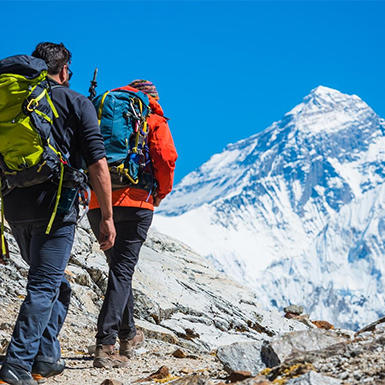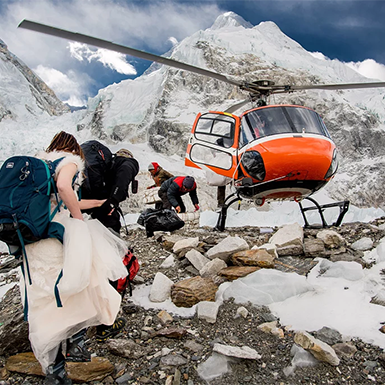Based on 14 reviews

Everest Base Camp Trek
Experience astounding mountain views with the team of Peregrine
Duration
Meals
- 11 Dinner
- 11 Lunch
- 14 Breakfast
Accommodation
- Three nights hotel
- 11 nights eco-lodge
Activities
- Trek to EBC
- Visit Monasteries
- Kathmandu Sightseeing
SAVE
US$ 370Price Starts From
US$ 1850
Overview of Everest Base Camp Trek
Everest Base Camp Trek is a once-in-a-lifetime experience that allows you to walk to the foot of the tallest peak in the world, Mt. Everest. Everest Trekking is featured in numerous international guidebooks, travel shows, and blogs thanks to its main attraction — Mount Everest.
Over 8,848.86m in elevation, the mighty Mount Everest soars proudly against the great background of the vast sky-like nature in paradise. The lap of this majestic mountain, “the Everest Base Camp” (5,364m/17,598ft), blossoms with breathtaking landscapes. The awe-inspiring snow-capped peaks add to the magic. An adventurous journey to Mount Everest’s base offers thrills and eye-catching landscapes. You can also immerse in the glorious Himalayan ranges, Sherpa culture, Buddhist monasteries, and wildlife.
Everest Base Camp Trek Highlights
- A thrilling and exciting flight to Lukla Airport– one of the most dangerous airports in the world
- An opportunity to explore Namche Bazaar, a classic mountain city, at your leisure
- Stand right at the base of Mount Everest in awe of its majestic size.
- Interaction with amiable Sherpa People and their unique culture
- Explore the best vantage point of Kalapatthar, which is a small peak in itself
- Witnessing the rare and endangered flora and fauna at Sagarmatha National Park (UNESCO World Heritage Site)
- The Breathtaking views of the highest Himalayan peaks, including Mt. Everest, Mt. Cho Oyu, Mt. Lhotse, and other peaks, throughout the journey
- Mt. Everest, Mt. Cho Oyu, Mt. Lhotse, and other peaks, throughout the journey
The stimulating effect of the trek begins as you land at the Lukla airport, and as you walk deeper into the Khumbu region, the beauty of Sagarmatha zones makes your heart flutter. Every morning, the journey’s excitement makes you forget the pain in your limbs, and you are ready to continue.
Our expertise is apparent in every trek detail, providing all participants with supportive tips throughout EBC & Kala Patthar’s journey to an elevation of 5,545 m /18,192 ft).
Detail Itinerary of Everest Base Camp Trek
Day 1: Arrival in Kathmandu (4,593 ft/ 1,400 m)
The green hills and the cultural spirit of Kathmandu are waiting for your arrival. If you are arriving in Nepal on a flight, our trek representative will be ready to pick you up at the airport terminal, holding a placard with your name. After exchanging a welcome greeting, we will drive you to the hotel.

Arriving by road, our representative will pick you up at a designated stop in Kathmandu.
Since no activities are planned for today, you can enjoy the rest and store your energy for the upcoming adventure. You can also stroll around the streets close to the hotel. In the evening, we will give an Everest Base Camp Trek briefing session.

Overnight at The Everest Hotel or similar.
Note: We need your flight/travel details for the airport/road transfer service. Please provide them 7 days before the tour departure date.
Day 2: Flight from Kathmandu (4,593 ft/ 1,400 m) to Lukla (9,350 ft/2,850m/) to Phakding (8,562 ft/ 2,650 m)
We begin the Everest Base Camp Trek (with some apprehension) with a flight to Lukla. The views of Himalayan vistas moving parallel to you and the lush forest below your feet are breathtaking; this will be a fun flight. After 45 minutes, the plane lands at Tenzing Hillary Airport at Lukla, where the Khumbu region’s prominent peaks will greet you.
After some preparation, we begin the Everest Base Camp Trek. The trek takes us first to Chaurikharka village. Then, we descend towards DudhkoshiGhat (8,300ft/ 2,530m) village of Lukla before reaching Phakding.
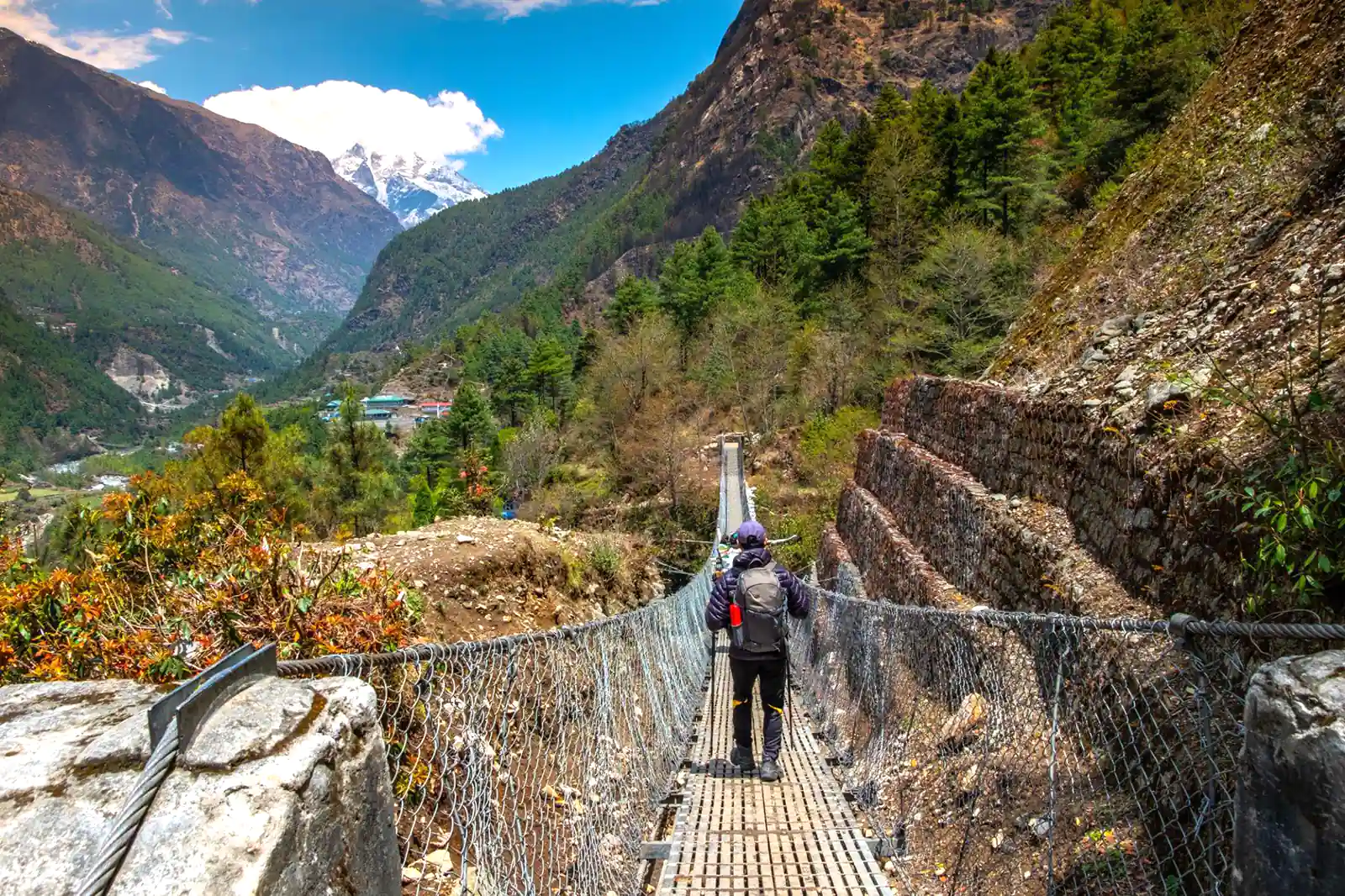
Today’s walk will be short and magical as we move slowly and steadily. You can visit the local monasteries (Rimishung Monastery) in your spare time. Give yourself enough rest for the long walk in the coming days.
Meals: Breakfast, Lunch, and Dinner
Accommodation at a local lodge
Note: For April, May, October, and November bookings, travel to Ramechhap by road and then fly to Lukla. We provide transportation for the Kathmandu-Ramechhap segment and arrange your return flight from Lukla to Ramechhap, followed by a drive back to Kathmandu. The Ramechhap drive takes about 5 - 9 hours.
Day 3: Trek from Phakding (8,562 ft/ 2,650 m ) to Namche Bazaar (11,285 ft/ 3,440m)- About 5-6 hours
Today, we start the trek quite early in the morning. We will explore the popular stops between Phakding and Namche Bazaar, such as Benkar, Jorsalle, and Monjo.
These tiny villages with huge stones carved in the Buddhist language share good luck and well wishes with the locals and travelers. It is believed that one should always walk clockwise to cross those carved stones. Thousands of prayer flags and giant Prayer wheels (Rotating bells) will delight you during the trek.

We shall stop at Everest’s lowest viewpoint, Thaktul Monastery (9,383 ft/ 2,860 m). Here, you will observe that the houses in this area are all used as tea houses and local Restaurants.
We’ll continue on the North bank of the DudhKoshi River. The chilling cold breeze of the river that flows on the right by our trail makes it even more exciting. The majestic view will keep us captivated, excitement filling our minds as we cross many suspension bridges over the river. The Hillary Suspension Bridge is the most well-known one.
At one point, you will see two suspension bridges hanging on the same Hill station, one after the other. As you cross these bridges, hearing the roaring current of the perennial river flowing below will get your nerves tingling.
We will pass Hillary Clinton prayer flags and Khata (a yellowish cloth used in important events). Then, a steep uphill trek takes us to Namche Bazar in the dense green pine forest, which is quite a distance.
Meals: Breakfast, Lunch, and Dinner
Day 4: Rest and Acclimatization at Namche Bazaar
Today is for rest and acclimatization. Even so, we will use the daytime to explore this beautiful village that once served as the trading center between the Nepalese and the Tibetans.
Thankfully, you will find numerous cafes, bakeries, restaurants with Wi-Fi, gear shops, souvenirs, etc. A short visit to Hillary’s school, old monasteries, and the museum is a delightful opportunity to learn about the Sherpas in the region. The Famous Khumjung Monastery has the Extinct Scalp of Yeti, which is not found in other parts of the world.

If you like exploring more, you can visit fantastic places like the Syangboche Airport (The highest-altitude Airport in Nepal) and Hotel Everest View. It’s been listed as the highest-placed hotel globally (13,000ft) in the Guinness Book of World Records (2004). The panoramic view of the mountain Vistas from the hotel is breathtaking.
Lastly, we will head to the yak farms- a perfect ending to a perfect day. Spend the evening relaxing before bed, preparing yourself for the trek towards Everest base camp the next day.
Meals: Breakfast, Lunch, and Dinner
Day 5: Trek from Namche (11,285 ft/ 3,440m) to Tengboche (12,850ft/ 3,855m)- About 6 hours
Tengboche is a place of outstanding handcrafted and natural beauty with stunning views of Mt. Everest, Lhotse, Nuptse, and AmaDablam. The trail is full of trek challenges that you might find arduous. But the spectacular views of the Himalayas range make it all worth it.
You will spot wildlife like musk deer, Himalayan Thar, and pheasant on the way. Further down to the DudhKoshi River, passing through the dense alpine forests, we shall find the small village called Phunki Thenga, which provides excellent views. We arrive at Tengboche, regaining our energy after the steep climb through a pine forest.
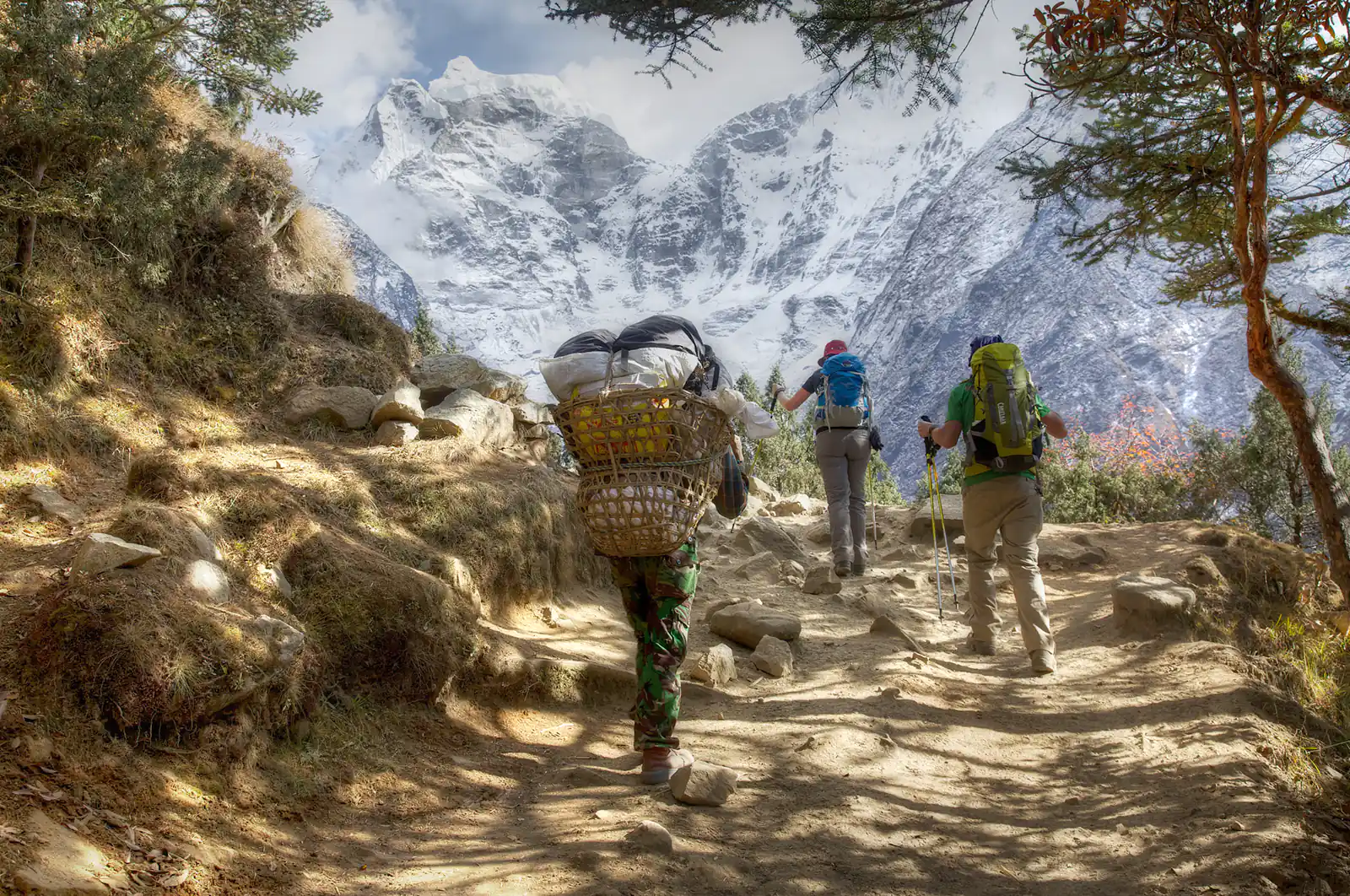
In the evening, we shall explore the biggest monastery in the Region, Tengboche Monastery. This monastery is also famous for meditation and prayers as a calm and quiet holy place.
Also known as “Incense Monastery,” one can hear the echo of air that struck the Himalayas, the chirping of birds, and the sounds of animals of that region. The Danfe (Himalayan colorful pheasant) and different kinds of musk deer make the journey exciting.
Meals: Breakfast, Lunch, and Dinner
Day 6: Trek from Tengboche (12,850ft/ 3,855m) to Dingboche (14,290ft/ 4,360m)- About 5 hours
The route to Dingboche at an elevation of 14,470 ft is such an enchanting experience. On the path, we’ll face the entire range of the mountain, smiling at us. One will fall in love with the spectacular creation of nature.
We’ll encounter peaks such as Lhotse (27,940 ft), Nuptse (25,791ft), Makalu (27,838 ft), Cho Oyu (8,189 m), AmaDablam (22,349 ft), Thamserku (21,680 ft, Island Peak (20,305 ft), Mera Peak (21,247 ft), Lobuche (16,210 ft), and more.
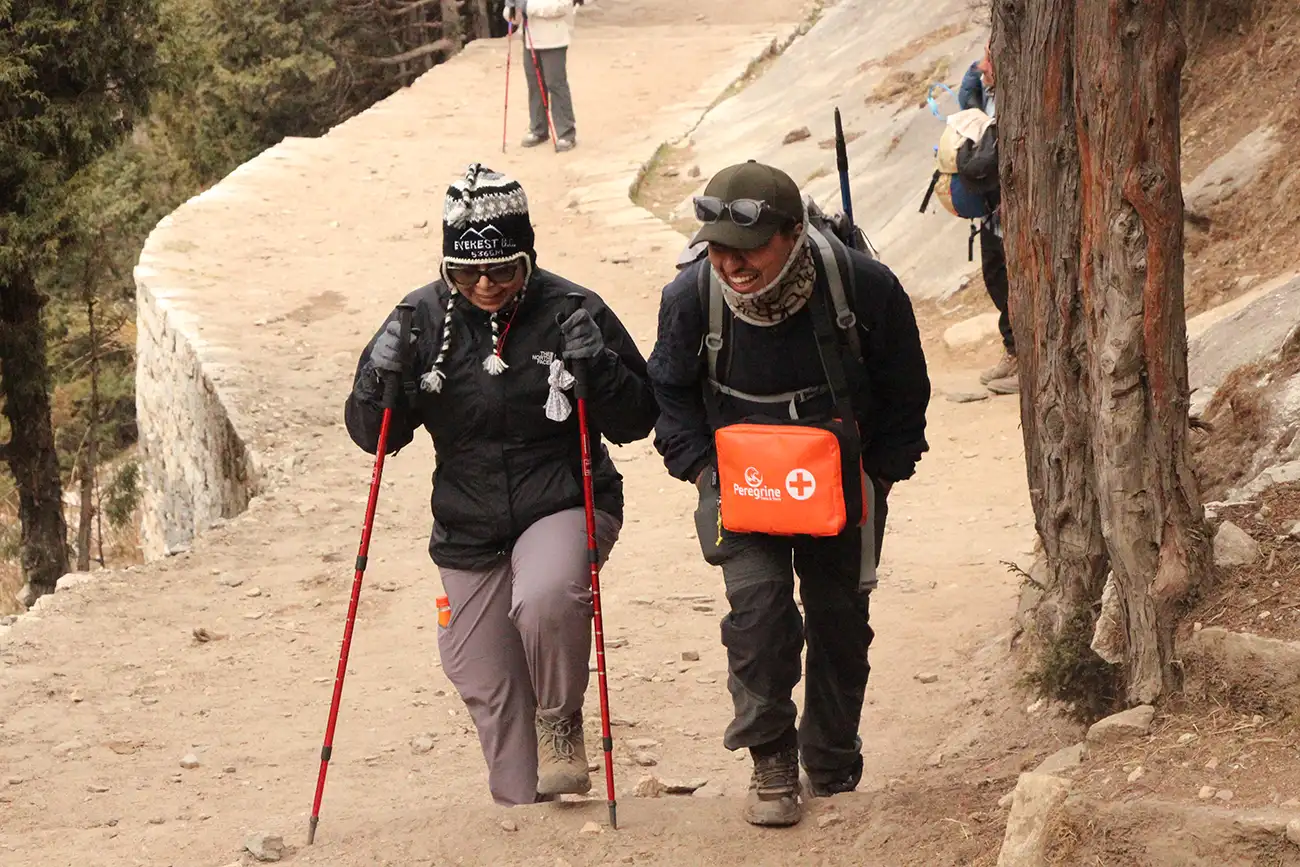
Along the way, we will encounter many stupas that appear out of nowhere. Then, the renowned “Pangboche Monastery” was built in the 16th Century—one of the oldest in modern history.
We can scrutinize the claws and skulls of the Yeti, the so-called loyal pet of ancient monks living in the Himalayas. Water drains from the frozen streams directly from the mountains. Then, the magical view of the sunset from Deboche brings your day to an end.
Meals: Breakfast, Lunch, and Dinner
Day 7: Rest day at Acclimatization at Dingboche
Our body demands acclimatization because we live at 4,360m above sea level. At Dingboche, we will give ourselves time to adjust to the thin air and avoid the low air pressure at higher elevations. Again, we will not be staying idle.
During the day, we will walk to the ridge above Dingboche and enjoy the breathtaking panoramic view of the snow-capped peaks such as Lhotse, AmaDablam, and Island. We shall take the route outside the village, heading south to a small hill with excellent views of the surrounding mountains.
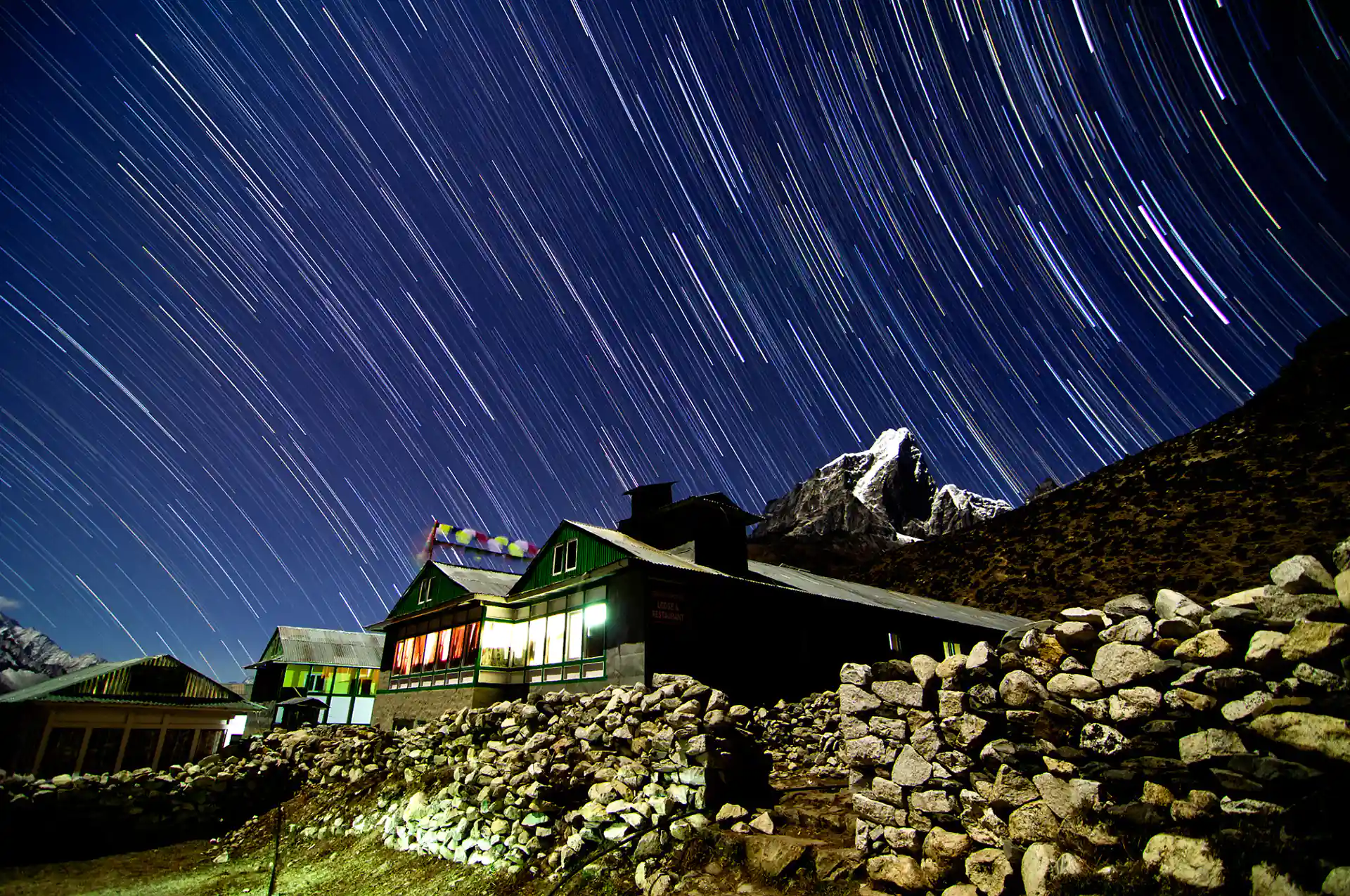
Makalu and Cho Oyu, the fifth and sixth-highest mountains globally, are also visible. To the north, one can see more Himalaya peaks that rise over the Khumbu Khola valley.
We take a day to wander around and witness the beautiful Dingboche village that looks like God’s untouched gem.
Meals: Breakfast, Lunch, and Dinner
Day 8: Trek from Dingboche (14,290ft/ 4,360m) to Lobuche (16,175 ft/ 4,930m)- About 6 hours
After a day’s rest, we are rejuvenated and ready to begin the trek again. The 8th day of the tour will be delightful as we can witness the spectacular mountain during the entire hike. The trail takes us to a shrine at the top of the ridge and deep into the broad valley.
Crossing a glacial moraine, we witness a perfect view of the peaks. When we reach “Thukla,” the Partial view of Lobuche greets us. Further trekking, the trail leads to the wonder of dreams- the beautiful alpine flora and rare fauna will make it exciting. On the way, you can see the memorial statues of the mountain climbers who passed away in this region.

The hike to Lobuche is inspiring and memorable. At an elevation of about 4,940 m ft, Lobuche is approximately 8.5 km southwest of Everest Base Camp. On arrival, we enjoyed a warm dinner and prepared for another exciting day.
Meals: Breakfast, Lunch, and Dinner
Day 9: Trek from Lobuche (16,175 ft/ 4,930 m) to Everest Base Camp (17,598 ft/ 5,364 m) and then back to Gorak Shep (17,010 ft/ 5,185 m)- About 7 hours
After relaxing at Lobuche, we head towards our final lodging place, the ascent trip to Gorak Shep. With excitement building up, we begin the trek early in the morning. Walking through the lateral moraine around Khumbu Glacier, we arrive at Gorak Shep quickly.
Continuing our dramatic journey toward base camp, we will pay attention to the Army Mountaineers Memorials. After a few hours, we arrive at the base of Everest Base Camp, our final destination.
Everest Base Camp is the closest we are getting to the highest mountain in the world; you get to leave your footprints right on the base of the world’s highest peaks. This is certainly a memory you will cherish for a lifetime.

We can contemplate the world and our place in it with pride in our hearts, a sense of wonderment, and deep emotion. We will capture some beautiful photographs and enjoy the view. The view of the world’s deepest glacier, Khumbu Glacier, will also please us. With so much satisfaction, it’s time to head back to Gorak Shep. After such an accomplishment, we can treat ourselves to a hearty dinner.
Meals: Breakfast, Lunch, and Dinner
Day 10: Hike to Kala Patthar (18,208ft/ 5,555m) viewpoint, trek to Gorak Shep to Pheriche (13,945ft/ 4,250m)- About 6 hours
Before dawn, without second thoughts, we hike to Kala Patthar, the second climax of the trip, to witness the most stunning sunrise on Mt. Everest. We’ll be trekking on the trails of the colorful hillside (decorated by flowering Rhododendron trees during spring); the overall surroundings would be so magical.
Our Everest Base Camp Trek takes us to the bridge over the ImjaKhola and goes into the Juniper forest. We walk at the ground level through the woods; we reach Dingboche. The trek is quite challenging, but it’s worth the hard work. Kala Patthar is the most popular viewpoint in the Khumbu region. The splendid view of Mt. Everest is better than the one from the base camp itself. You will see colorful prayer flags as we climb above the rocky trails on the top.
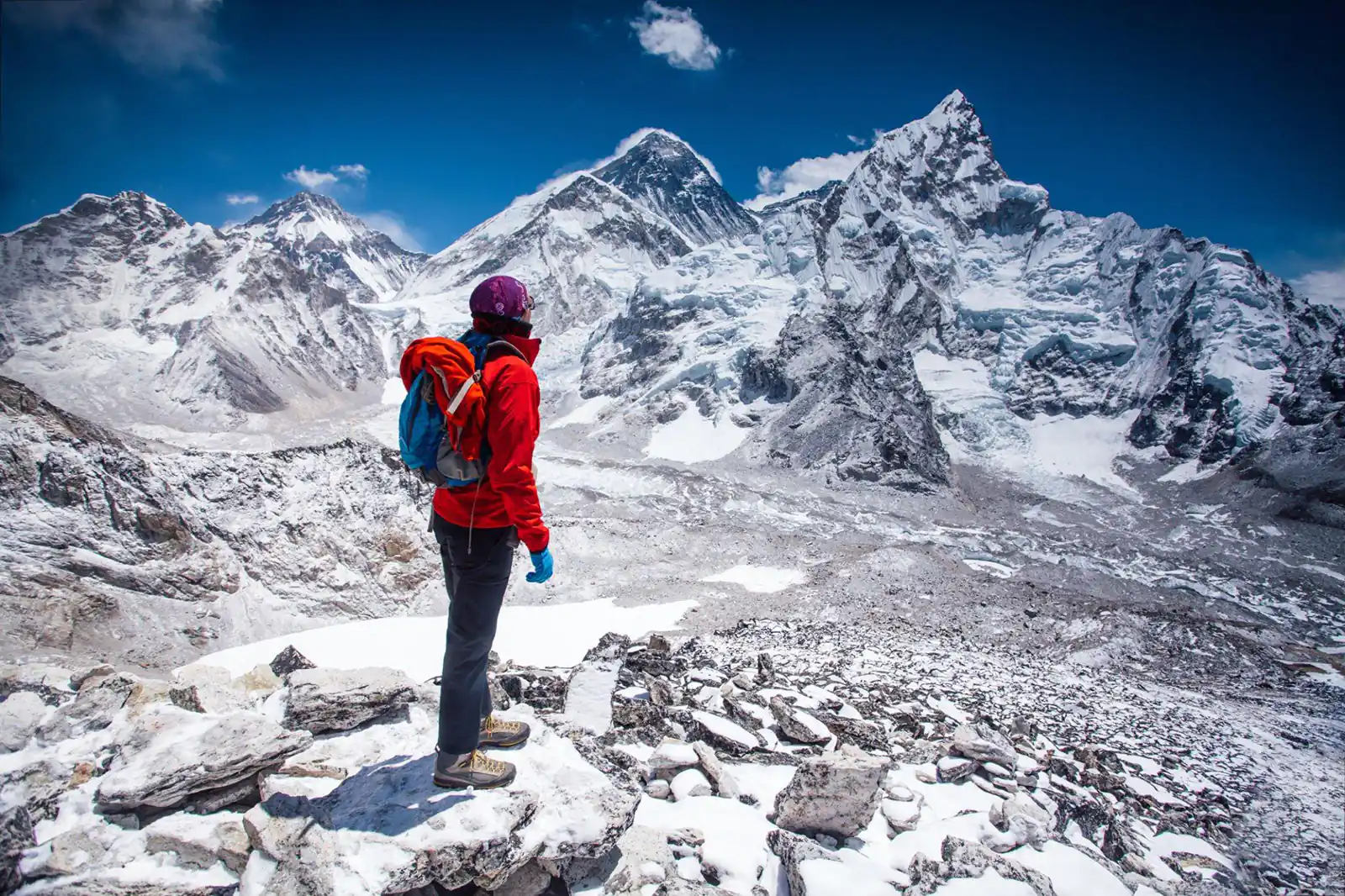
After some exhilarating hours at the top, we’ll trek back to Gorakshep for breakfast. Then it’s time to return to Pheriche, the small stunning village. Reflecting on an unforgettable memory of Mt. Everest, the trek downward will be enjoyable. The trail to Pheriche is full of forests and meadows along the way.
Meals: Breakfast, Lunch, and Dinner
Day 11: Trek from Pheriche (13,945ft/ 4,250m) to Namche Bazaar (11,285 ft/ 3,440m)-About 6 hours
Another day of easy walking! We will resume the descent after a hot breakfast at our teahouse. We commence the trek by crossing the river and walking on the riverbank’s right side toward Shomare and Pangboche. A short walk from Pangboche takes us above a suspension bridge.
The other walk takes us to the valley of Tengboche, a place with beautiful monasteries. After some rest, we move on as the trail descends on the river bank and make a final ascent to the village of Kyangjuma.
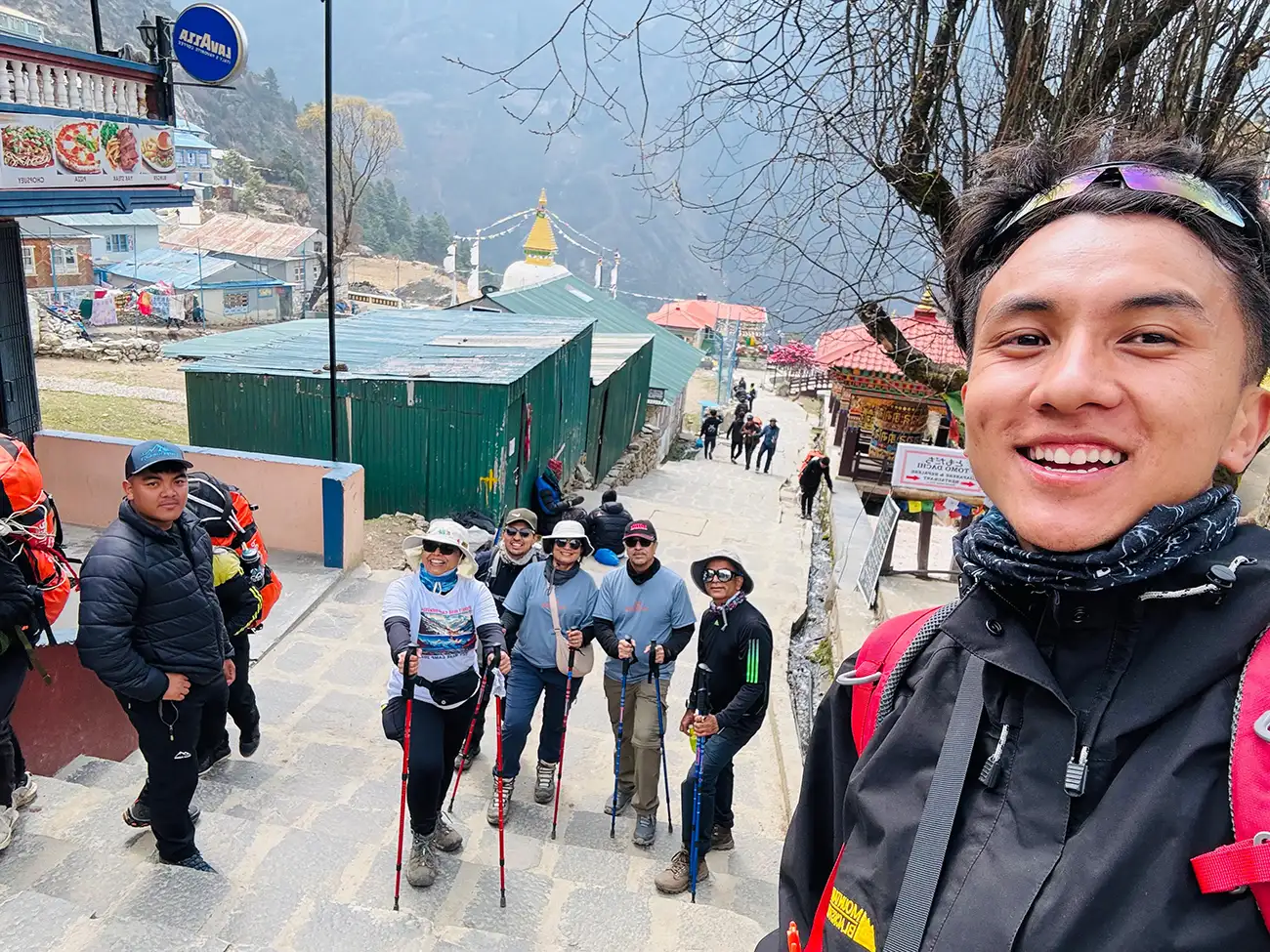
The trek takes 7 to 8 hours, but the path is mostly downhill and easy. After a short uphill, we reach the ridge leading to Namche. Being in Namche, you will feel very welcomed and relaxed.
Meals: Breakfast, Lunch, and Dinner
Day 12: Trek from Namche Bazaar (11,285 ft/ 3,440m) to Lukla (9,350 ft/ 2,850m)- About 6 hours
Get ready for your final day on the Khumbu trekking trail. The day will be rewarding as we return down the Dudh Koshi Valley. The course is generally quite gentle and fun. Before rushing on to Lukla, the path heads steeply to the west.
As we arrive in a small village, we rest before taking a junction into the trees. The village’s path leads to the main trail as we join the sidestream before Toktok. From Toktok, we walk for some time before arriving in the large town of Lukla.
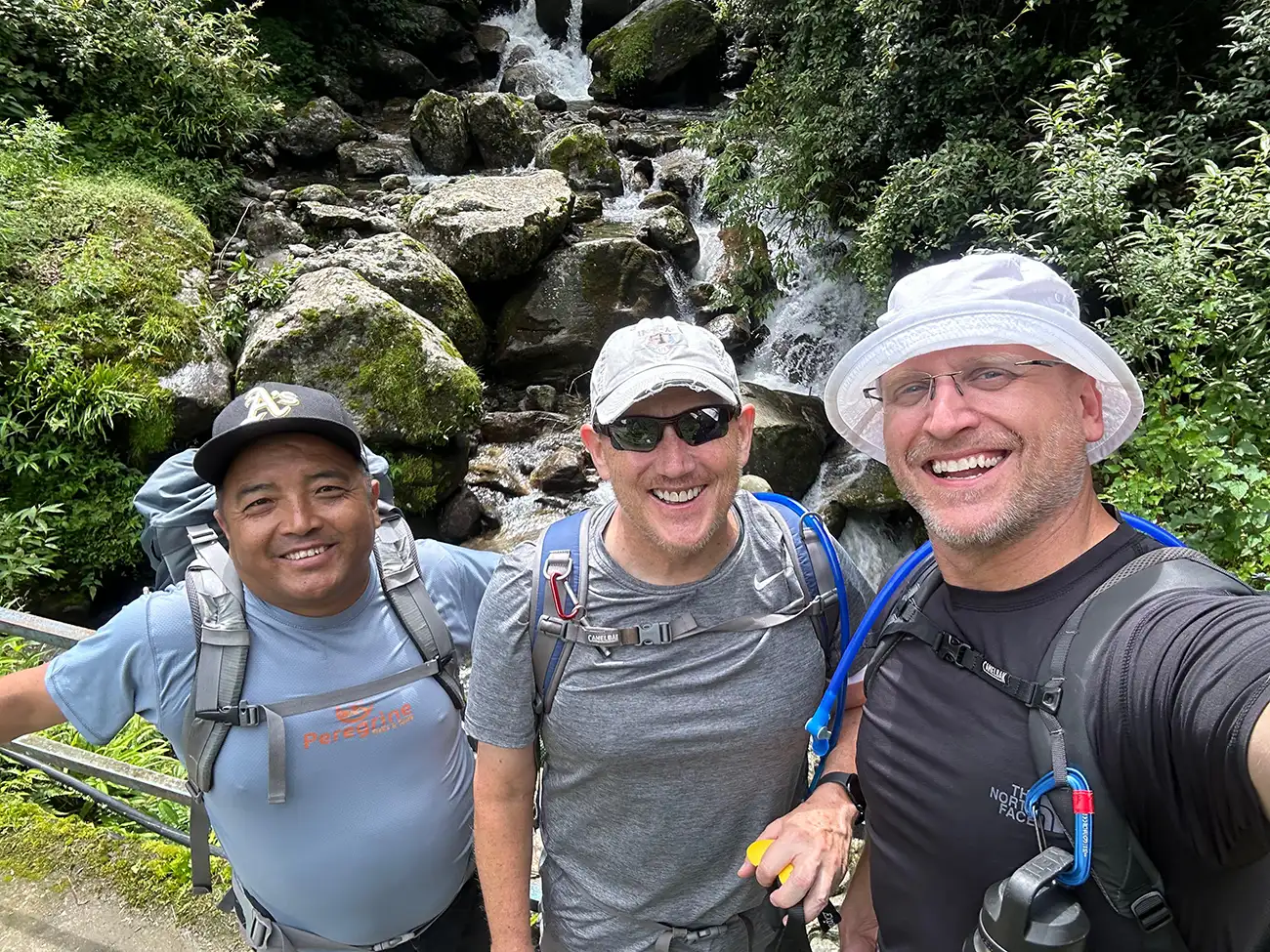
You can stroll around and enjoy nature while still being in the Khumbu region. Let your body relax with the cool mountain breeze caressing you.
Meals: Breakfast, Lunch, and Dinner
Day 13: Fly back to Kathmandu (4,593 ft/ 1400m) from Lukla (9,350 ft/ 2,850m)
If everything goes according to schedule, we will fly back to Kathmandu in the early morning. Wave a final goodbye to the Sagarmatha region before hopping into the plane. The 45-minute flight back to the capital city will be relaxing. The unforgettable and successful memory of Everest will accompany you.
For the rest of the day, you can enjoy the beauty of this remarkable city. You can wander around the hotel or rest in your hotel. We suggest you walk around during the evening and enjoy the nightlife of Thamel. It’s up to you.
Meals: Breakfast
Accommodation: The Everest Hotel or a similar
Day 14: Sightseeing around Kathmandu
Today, we explore Kathmandu’s UNESCO World Heritage sites. We start at Swayambhunath Stupa, which offers panoramic views of the valley. Next, we visit Kathmandu Durbar Square, the former royal palace. Finally, we seek blessings at Pashupatinath Temple, Nepal’s most important Hindu shrine.

Conclude your day with a farewell dinner celebrating your successful journey.
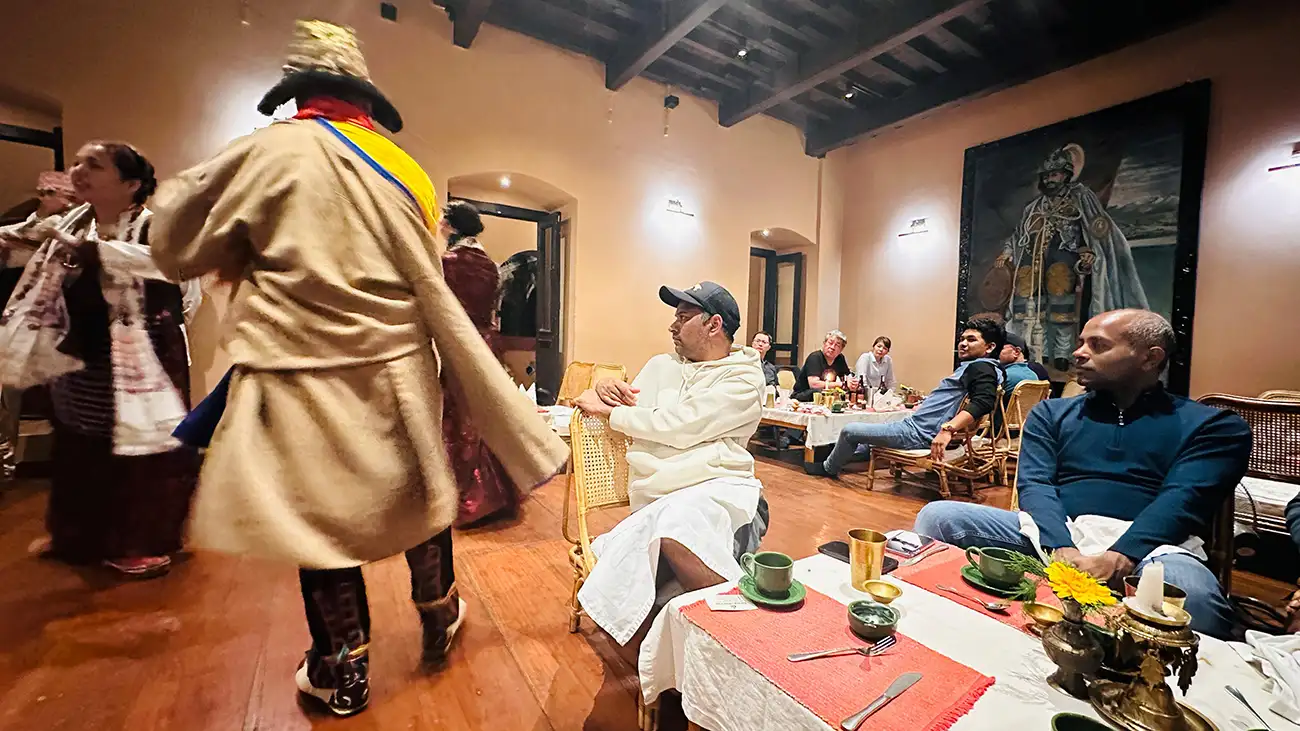
Meals: Breakfast
Accommodation: The Everest Hotel or a similar
Day 15: Departure
After a leisurely breakfast, we’ll drive you to the airport. Please let us know your flight details so we can ensure a timely departure.
We’ll accompany you to the airport three hours before your flight to assist with customs and immigration procedures. As you board your flight, take unforgettable memories of your Everest Base Camp adventure.
Meals: Breakfast
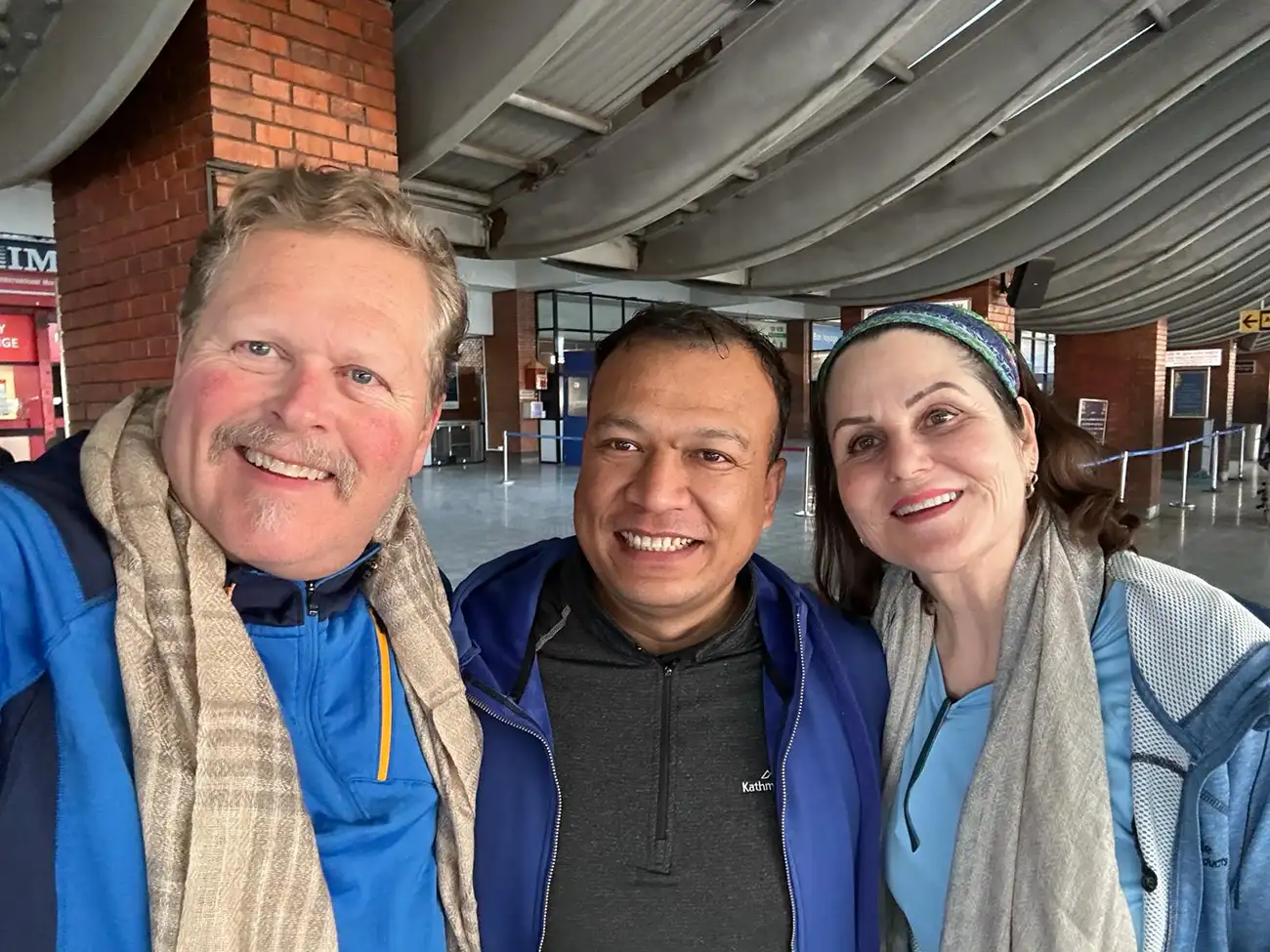
Customize this trip with help from our local travel specialist that matches your interests.
Includes & Excludes
What is included?
- Comprehensive Transportation: All ground transportation within Kathmandu, as outlined in your itinerary, is included. This ensures seamless travel between destinations.
- Guided Kathmandu Exploration: Experience the rich culture of Kathmandu Valley with included guided sightseeing tours. Entrance fees to all visited sites are covered for your convenience.
- Comfortable Kathmandu Stay: Relax in comfort at The Everest Hotel in Kathmandu before and after your trek.
- Everest Base Camp Accommodation: Throughout the trek, comfortable lodge accommodation is provided at each stop along the Everest Base Camp route.
- Scenic Flights: Round-trip flight tickets between Kathmandu and Lukla are included, offering breathtaking aerial views of the Himalayas.
- Delicious Meals: Nourish yourself with delicious meals as detailed in the itinerary, providing the necessary fuel for your trek.
- Expert Guidance: A dedicated English-speaking guide will accompany you throughout the trek, sharing their knowledge and ensuring a safe and informative experience. Essential porters are also included to assist with luggage transport.
- Permits and Taxes: All necessary permits for the Everest Base Camp Trek, including TIMS (Trekkers’ Information Management System), are covered for your convenience. All relevant taxes are also included in the package price.
What is excluded?
- Nepal Visa Fee and international airfare.
- Lunch and dinner while in Kathmandu.
- Additional hotel accommodation in the event of an early return from the Everest Base Camp Trek.
- Personal expenses include hot showers, battery charging, internet usage, bar and beverage bills, pots of tea/coffee, laundry, etc.
- Gratuities for the guide and porter (while not obligatory, they are highly appreciated).
Departure Dates
We also operate Private Trips.
Route Map

The classic Everest Base Camp Trek itinerary commences and ends in our capital, Kathmandu. On the nine-day journey, you will discover the small villages dotted with fluttering prayer flags. You get a closer insight into the colorful Buddhist and Hindu cultures and traditions.
First and foremost, the tingling 45-minute flight from Kathmandu to Lukla Airport takes you to the starting hub of this best tour in Nepal. We gear up to walk towards another beautiful Everest valley of Phakding, where the Himalayan farmland will greet us.
Crossing the traditional villages and the suspension bridges on the way, the spectacular view of the Khumbu region will keep amassing us. Walking along the Dudh Koshi River, we’ll encounter many Suspension bridges that might make us quiver. The next day, we shall check in to Sagarmatha National Park and proceed towards Namche Bazar (3,440 m).
As we are already walking high in the mountain region, our bodies need to acclimate to gain altitude. After a day of rest in this beautiful settlement that looks straight out of some Sci-fi movie, we move onward. The route takes to Tengboche and Dingboche before arriving at the Lobuche.
After a relaxing night at Lobuche, we move towards the final lodging place of the integral trek: Gorakshep. Yeah, you heard that perfectly; it’s our last lodging place before we explore Everest’s base camp and the famous Kalapatthar the following day while leaving our footprint on the Base Camp and Kalapatthar.
Please read our blog, “A Complete Guide to Everest Base Camp Trek, for more info.”
Good To Know
The Everest Base Camp Trek is an incredible adventure that takes you through some of the most breathtaking landscapes on Earth. Packaging the right gear is essential to make your trek comfortable and enjoyable. This guide provides a detailed list of items to help you prepare for the unique demands of this high-altitude experience.
Head and Neck Essentials
Protecting your head and neck from harsh weather conditions is crucial in the Everest region.
- UV-Protective Sunglasses: Shield your eyes from intense sunlight and snow glare at high altitudes.
- Breathable Sun Hat: Keeps your head cool while safeguarding it from the sun’s rays.
- Neck Gaiter or Buff: A versatile piece that offers warmth and protects against dust and wind.
- Warm Scarf: Provides additional insulation in cold temperatures.
- Insulated Winter Cap: Essential for keeping your head warm during chilly mornings and evenings.
Upper Body Clothing
Layering your clothing helps you adapt to changing weather conditions throughout the trek.
- Thermal Base Layers: Moisture-wicking materials keep you warm and dry.
- Lightweight Trekking Shirts: Comfortable and breathable shirts suitable for hiking.
- Fleece Jacket: Offers warmth without adding extra weight.
- Waterproof Shell Jacket: Protects against wind, rain, and snow.
- Insulated Down Jacket: Vital for extreme cold at higher elevations.
Lower Body Clothing
Comfortable and durable pants are essential for long days of trekking.
- Thermal Leggings: Serve as a warm base layer under your trousers.
- Trekking Pants: Lightweight, quick-drying pants ideal for various conditions.
- Warm Hiking Trousers: Provide extra warmth when temperatures drop.
- Waterproof Over-Trousers: Keep you dry during rain or snow.
Footwear
Proper footwear ensures comfort and prevents injuries on uneven terrain.
- Sturdy Trekking Boots: Well-fitted, waterproof boots with good ankle support are essential.
- Comfortable Camp Shoes: Lightweight footwear like sandals for relaxing at lodges.
- Woolen Socks: Warm socks to dry your feet; bring several pairs.
- Liner Socks: Thin socks are worn under woolen socks to prevent blisters.
Hand Protection
Keeping your hands warm is essential for comfort and functionality.
- Inner Gloves: Lightweight gloves for mild conditions.
- Insulated Waterproof Gloves: Protect your hands from cold and wet weather.
Backpacks and Bags
Organize your belongings efficiently with suitable bags.
- Daypack (30-40 liters): Carry essentials like water, snacks, and a camera.
- Duffel Bag: Porters use this to carry your main luggage; ensure it’s durable.
- Money Belt or Waist Pouch: Keep valuables like your passport and money secure.
Essential Accessories
These items enhance safety and comfort during your trek.
- Headlamp with Extra Batteries: Useful for early starts or navigating in the dark.
- Personal First Aid Kit: Include essential medicines and any personal prescriptions.
- Trekking Poles: Help with balance and reduce strain on knees.
- Water Bottles or Hydration Bladder: Stay hydrated by carrying sufficient water.
- Water Purification Tablets: Ensure your drinking water is safe.
- Sunscreen and Lip Balm: Protect your skin and lips from intense UV rays.
- Sunglasses with UV Protection: Essential for eye protection.
- Hand Sanitizer and Wet Wipes: Maintain hygiene when facilities are limited.
- Sleeping Bag (-10°C to -15°C rating): Provides warmth during cold nights.
- Travel Pillow: Adds comfort to your sleep.
Optional Specialized Gear
Depending on the season and your preferences, consider these additional items.
- Gaiters: Prevent snow or debris from entering your boots.
- Crampons or Microspikes: Offer extra traction on icy trails.
- Portable Charger: Keep electronic devices powered.
- Camera with Extra Batteries: Capture memories of stunning landscapes.
Health and Safety Items
Prioritize your well-being with these essentials.
- Face Mask or Buff: Protects against dust and cold air.
- Antibacterial Hand Gel: Helps prevent illness.
- Blister Care Supplies: Moleskin or blister pads for foot care.
- Altitude Sickness Medication: Consult your doctor before the trek.
Final Preparation Tips
- Consult Experts: Reach out to us for personalized advice based on the season.
- Test Your Gear: Break in new boots and try out equipment before the trek.
- Pack Lightly: Bring only what you need to keep your load manageable.
- Stay Informed: Be aware of weather forecasts and altitude challenges.
Packing thoughtfully ensures you can enjoy the Everest Base Camp Trek without discomfort. With the proper preparation, you’ll be ready to explore the majestic Himalayas and create unforgettable memories.
Related Article: How to Prepare for Everest Base Camp Trek
We accept payments in various significant currencies to ensure a smooth and convenient booking process for our Everest Base Camp Trek. These include:
- US Dollar
- British Pound
- Euro
- Australian Dollar
- Singapore Dollar
- Indian Rupee
- Swiss Franc
- Canadian Dollar
- Japanese Yen
- Chinese Yuan
- Saudi Arabian Riyal
- Qatari Riyal
- Thai Baht
- UAE Dirham
- Malaysian Ringgit
- South Korean Won
- Swedish Krona
- Danish Krone
- Hong Kong Dollar
- Kuwaiti Dinar
- Bahraini Dinar
By accepting these currencies, we aim to provide a hassle-free experience for travelers worldwide. Whether you’re joining us from Europe, Asia, the Middle East, or elsewhere, you can make payments in your local currency for the Everest Base Camp Trek without complications.
In Nepal, including during the Everest Base Camp Trek, the standard voltage is 230V with a frequency of 50Hz, and the power plugs and sockets used are Types C, D, and M. If you’re traveling from a country with different plug types, it’s essential to bring a suitable adapter, and a universal adapter is highly recommended for charging your devices quickly. Additionally, ensure that your electronics support 230V to prevent any damage. Most hotels and trekking lodges in Nepal have reliable electricity, so being prepared with the right adapters and compatible devices will help you stay connected and enjoy your adventure without any electrical issues.
Before starting your Everest Base Camp Trek, it is advisable to get vaccinated for Hepatitis A, Typhoid, and Tetanus. Vaccines for Rabies, Japanese Encephalitis, and Malaria may also be recommended depending on your specific activities and the areas you plan to visit. Although no vaccines are required to enter Nepal, consulting with your doctor before your trek is essential. Your doctor can provide personalized advice based on your health and travel plans, ensuring you are fully prepared for a safe and enjoyable Everest Base Camp Trek.
To ensure a seamless arrival in Nepal for your Everest Base Camp Trek, it is highly recommended to complete the online visa application in advance. Visit the official Nepal Immigration website to fill out the form, which will help you save valuable time upon arrival. Most travelers can obtain a visa on arrival at Nepal’s entry points. However, citizens from countries such as Nigeria, Ghana, Zimbabwe, Swaziland, Cameroon, Somalia, Liberia, Ethiopia, Iraq, Palestine, Afghanistan, and Syria must secure their visas through the nearest Nepalese embassy or consulate.
The fees for tourist visas are USD 30 for 15 days, USD 50 for 30 days, and USD 125 for 90 days. By completing the online application before your trek, you can ensure a more efficient and hassle-free entry into Nepal, allowing you to focus on enjoying the breathtaking adventure of the Everest Base Camp Trek.
Our website supports payments in major currencies such as USD, CAD, GBP, Euro, and AUD. Suppose you are from a country that uses these currencies. In that case, you can conveniently transfer funds directly from your bank account, helping you avoid the additional 3% fee associated with credit card payments. A deposit of at least 30% of the total cost is required to secure your spot on the Luxury Everest Base Camp Trek. The remaining balance must be settled 30 days before your arrival. Additionally, we accept major credit cards, including Visa, Maestro, MasterCard, and American Express. Please note that paying with a credit card will incur extra fees on top of the tour price.
For a smooth and connected Everest Base Camp Trek, we highly recommend purchasing a SIM card to ensure reliable internet access in Nepal. The two leading providers are Nepal Telecom (NTC), which is government-owned, and NCELL, a private company. The best place to buy your SIM card is at the airport, where staff can help you activate it and choose the right data plan. Alternatively, you can obtain an eSIM at Kathmandu Airport. Having a local SIM card makes contacting us and finding our airport representative easier.
You can access free WiFi during your trek at the Everest View Hotel on Day 5 of the Everest Base Camp Trek. Starting from Day 6, you must purchase an internet package for about USD 6-7 to get 24-hour WiFi access, which is only available at the lodge. In areas like Lukla, Namche, and Tengboche, your mobile phone and data should work well, mainly if you use an NTC SIM card, which is more reliable than NCELL.
Mobile data might occasionally work in Dingboche and Gorakshep, but internet access is unavailable in Lobuche and Pheriche. Being prepared with the correct SIM card and understanding the connectivity options will help you stay connected and enjoy your Everest Base Camp Trek without interruptions.
You can charge electronic devices like mobile phones, cameras, and power banks for free up to Namche during your Everest Base Camp Trek. After Namche, lodges typically charge around USD 4-5 to recharge your gadgets. Electricity is available throughout the entire trek, ensuring your devices stay powered. For added comfort, most lodges offer electric blankets for an additional fee of USD 15-20 per night. These amenities help make your Everest Base Camp Trek both comfortable and convenient, allowing you to enjoy the stunning Himalayan scenery without worrying about your electronics.
Trip Information
Natural Experience
The Everest Base Camp Trek is rich in terms of natural attractions. In lower areas, the trail passes through lush forests where you can hear birds singing high above the forest canopy.
You can see small creeks crossing the trail, making you feel rejuvenated. While the lower areas have lush oak and pine trees, the higher regions have birch, juniper, and pine forests. However, you can see only shrubs and arid landscapes beyond the tree line.
Getting there
Lukla serves as the primary entry point to the Everest region. Situated a mere 40-minute flight from Kathmandu, this hillside town is easily accessible by air. For those seeking a more extended trekking experience, there’s an alternative route starting from Jiri; however, this journey takes an additional five days to reach Lukla.
Packing List
The packing list depends on the trekking season. We will provide you with the list of trekking equipment well in advance. No technical trekking equipment is required for this trek. A three-season plus sleeping bag will be enough for you.
How much does the trek cost?
The price of trekking in Nepal varies based on the chosen tour package (either deluxe or standard), the number of participants in the group, and the specific services needed, with the standard package priced at USD 1850 per person.
Related Article: Everest Base Camp Trek Cost
Extensions
There are plenty of trip extensions in the Everest region. You can take a trip to the Gokyo Lakes or visit the Imja glacial lake. You can also stay a few more days in the village to learn more about Sherpa culture, traditions, and lifestyle. If you want to lengthen your itinerary, talk with your tour operators, who will handle it.
Altitude Mountain Sickness (AMS) in Everest Base Camp Trek
On the Everest Base Camp trek, altitude sickness is widespread. It can happen to anyone regardless of age, fitness level, or previous trekking experience. One should be careful not to get hit by AMS on the way. One of the main reasons for AMS is trekking with no acclimatization days. Trekkers rush to complete the trek, avoiding the fear of AMS, so they can’t complete the tour. Anyone can face altitude sickness; knowing some common symptoms of AMS is essential.
- Poor appetite
- Fatigue
- Dizziness
- Difficulty in sleeping
Don’t worry; AMS can be prevented as well. Some of the measures to avoid the risk of AMS are:
- Hydrate your body. Drink plenty of water.
- Don’t rush or walk fast to match your friend’s speed. Take your time and walk at your own pace.
- Seek doctors for medical attention before the trek. Use only recommended drugs. Most people use Diamox.
Transportation
This package includes a hotel transfer and sightseeing tour in a private air-conditioned vehicle with a personal driver and guide. The domestic flight from Kathmandu to Lukla and later Lukla to Kathmandu is included in the cost.
Packing
The trek to Everest Base Camp Trek requires definite preparations and checklists of trekking gear & equipment. We shall forward you the recommended packing list before the tour. You will not need any climbing equipment for the EBC journey.
Everest Base Camp Trek safety
The classic Everest base camp trek in the Solukhumbu District of Nepal is safe to travel to. Our itinerary was designed by an expert who analyzed all the altitude and health risk factors. With enough days for acclimatization and only 5-6 hours of daily walking on average, you can easily accomplish the trek.
In cases of difficulty, you will get first-aid treatment from the guide. And for an emergency, we will arrange a Helicopter Rescue if your insurance covers such a charge. In conclusion, the trek is very safe.
Also, post-covid-19 arrangements are in place to ensure your good health. Our guides are well-trained in Intensive wilderness First Aid.
Don’t Worry; We’ll Pick You Up!
Our representative crew will meet you on arrival, regardless of your flight time.
No confusion, No dilemma, No worrying
Best time for Everest Base Camp Trek
The classic EBC trek has been one of the best trekking places in the world since the 90s. Though the trek is fun and exciting all year round, the warm and stable climate can be a huge plus. Ideally, Autumn (September, October, and November) offers the best views and warmth. Spring (April, March, and May) has wildflowers and lively weather to greet you. The Magic of clear azure skies bestows with the most spectacular vistas. The temperature is also exquisite, with bright sunlight.
During the winters and monsoons, the trek becomes challenging due to cold temperatures and the slippery path, which excites many trekkers. However, with proper preparations, the Everest Base Camp hike is possible throughout the year—each season has its advantages.
Related Article: Best Time for Everest Base Camp Trek
Trekking group/single
We organize the trek for groups and single travelers. The group’s price is somewhat lower, but you can enjoy the luxury of private touring. We will lead any group size with an experienced leader guide, porters, and assistant guides.
Communication on trek
Internet service is available at the tea houses with some extra service charge. You can use the Nepalese mobile network to make calls and use the internet. We can provide a separate local SIM card for good access at your request.
Travel Insurance
The Everest Base Camp Trek is arduous as it entails the risk of high-altitude trekking, sudden climate change, and potential altitude sickness. To ensure your safety, you must provide details of your comprehensive travel insurance policy certificate before commencing the trek. Moreover, your travel policy must cover medical and emergency repatriation, helicopter rescue, and evacuation expenses up to 6000m for trekking members.
Related Article: Nepal Trekking Insurance
Money Exchange
Nepal uses Nepali Rupees (NPR/Rs) as the local currency.
(1 USD = ~ Rs.120-130 NPR).
You can exchange most foreign currencies at local banks or legitimate money exchanges in Kathmandu. Small amounts can also be exchanged at the hotel.
We would love to stand in an ideal world on the world’s apex (8,848m) on Mt Everest. Realistically, most of us cannot achieve this! But with strong determination, we can make it to its base! Getting to the Base Camp is an outstanding achievement, and the views are just awe-inspiring. So, are you ready to challenge yourself and make the most beautiful journey of your life with us?
Well, you should.
Happy trekking!!!
Frequently Asked Questions
You need to complete the following steps.
- Click on the Book Now Button and wait for a few seconds
- Choose the date, and you will see the payment option (Deposit amount of full payment)
- Fill in the form and accept our terms and conditions
- Pay by US Checking account or by your credit card
- Send the screenshot to us
After getting the payment screenshot, we will provide the tour confirmation voucher, which you must show at Kathmandu airport for airport transfer service.
If you cannot join the trip on the confirmed date, you can postpone it to another date without any additional charges until the end of the same year. However, if you wish to transfer the tour to the following year, a 10% additional amount will be applicable. Please inform us at least 30 days before your tour departure date.
The weight limit for your primary luggage should be 9 to 10 kg per trekker. The porters will carry your luggage. It would help to have your knapsack/ backpack with your valuable devices and snacks. You can leave excess baggage at your hotel or our office, which will be completely safe.
15-Day Everest Base Camp Trek is challenging and equally rewarding. It is a physically demanding trip that demands proactive preparation to succeed. Novice trekkers with sound fitness levels achieve EBC hikes successfully.
Exercising and jogging for a couple of weeks before the trek departure is an excellent idea to enhance our stamina. Cycling and swimming can be ideal for preparing your body for the trek. Before heading to Nepal, you can also take high-altitude excursions to your home country.
On the journey to Everest Base Camp, participants will walk 6 to 8 hours daily. It’s a test of stamina and an adjustment to the high altitudes. To prioritize the safety and well-being of trekkers, we’ve scheduled two specific days for acclimatization. These pauses are essential to let the body adapt to the lower oxygen levels, reducing the risk of altitude sickness and ensuring a more comfortable trekking experience.
The journey to Everest Base Camp involves a trek spanning approximately 130 kilometers, encompassing the ascent to the base camp and the return descent. This distance provides trekkers with a challenging yet rewarding experience as they traverse diverse terrains and witness breathtaking views of the Himalayas while making their way to the base of the world’s highest peak.
Kalapatthar, standing at an elevation of 5,545 meters, represents the pinnacle of the Everest Base Camp Trek. While Everest Base Camp is a significant milestone, from the vantage point of Kalapatthar, trekkers are rewarded with the most panoramic and unobstructed views of Mount Everest and its surrounding peaks. This spot is often the highlight for many, offering a breathtaking perspective of the world’s highest mountain.
No, there is no ATM service at any of the locations in the Everest Region. There are ATM facilities only in Lukla and Namche Bazaar. So, make sure you carry enough cash for the trek. Only Nepali currency is valid, and teahouses won’t accept card and dollar transactions.
Be aware; you might. As the elevation on this trek will exceed 5000m, you cannot neglect the chances of getting altitude sickness. If you give your body enough time to acclimatize, drink a lot of water, and eat healthily, you will likely reduce the sickness.
We will collect information regarding your travel insurance policies before the trek. We coordinate with the insurance company and arrange for helicopter providers for evacuation in case of any emergency.
Everest Base Camp is one of two base camps on opposite sides of Mount Everest. South Base Camp is located in Nepal at an elevation of 5,364m, while North Base Camp is located in Tibet at 5,515m.
Mountaineers primarily use these South Base Camps to climb and descend the world’s highest mountain. Everest Base Camp is located in the Solukhumbu district of Nepal.
It depends upon the itineraries you choose. There are different trekking routes, and you can customize your trip. We can do the classic Everest Base Camp Trek in 15 days from Kathmandu.
Lukla to Phakding
- Starting elevation: 9,100 ft / 2,800 m
- Ending elevation: 8,563 ft / 2,610 m
- Starting oxygen: 72% of sea level
- Ending oxygen: 74% of sea level
- Distance covered: 4.66 mi / 7.5 km
- Time hiked: 3h 00m
EBC Phakding to Namche
- Starting elevation: 8,563 ft / 2,610 m
- Ending elevation: Namche Bazaar (11,286 ft / 3,440 m)
- Starting oxygen: 74% of sea level
- Ending oxygen: 70% of sea level
- Distance covered: 8.0 km / 5 miles
- Time hiked: 6h 00m
Namche Bazaar to Deboche/Tengboche
- Starting elevation: 11,290 ft / 3,440 m.
- Ending elevation: 12,687 ft / 3,867 m.
- Elevation change: +1,397 ft / +427 m.
- Starting oxygen: 67% of sea level.
- Ending oxygen: 64% of sea level.
- Distance covered: 5.72 mi / 9.2 km.
- Time hiked: 6h 00m
Tengboche / Deboche to Dingboche
- Starting elevation: 12,697 ft / 3,870 m.
- Ending elevation: 14,469 ft / 4,410 m.
- Elevation change: +1,772 ft / +540 m.
- Starting oxygen: 64% of sea level.
- Ending oxygen: 59% of sea level.
- Distance covered: 6.71 mi / 10.8 km.
- Time hiked: 5h 30m.
Dingboche to Lobuche
- Dingboche Elevation: 14,469 feet / 4,410 meters
- Lobuche Elevation: 16,109 feet / 4,910 meters
- Distance: 4.9 miles / 7.9 kilometers
- Duration: 5 Hours
- Elevation Gain: 2,008 feet / 612 meters
- Net Elevation Gain: 1,640 feet / 500 meters
Everest Base Camp: Lobuche to Gorakshep
- Starting elevation: 16,142 ft / 4,920 m
- Ending elevation: 16,863 ft / 5,140 m
- Elevation change: +721 ft / 220 m
- Starting oxygen: 56% of sea level
- Ending oxygen: 54% of sea level
- Distance covered: 2.67 mi / 4.3 km
- Time hiked: 3 h 00 m
Gorak Shep to EBC
- Starting elevation: 16,863 ft / 5,140 m.
- Ending elevation: 17,598 ft / 5,364 m.
- Elevation change: +735 ft / 224 m.
- Starting oxygen: 54% of sea level.
- Ending oxygen: 53% of sea level.
- Distance covered: 2.17 mi / 3.5 km.
Time hiked: 2h 00m to EBC (4h 30m roundtrip)
The most challenging part of the Everest Base Camp trek is altitude, which makes the tour difficult for most trekkers as many factors make your hiking difficult. The bag pack, the trekking season, and your fitness determine your trek. The highest altitude on the Everest Trek is 5545m. So, you can imagine the rise in height on the hike.
However, one must be moderately fit physically and mentally. In recent years, people of all age groups have completed the Everest Base Camp Trek. Ensure you have a proper acclimatization day of 2 days in your itineraries. Don’t rush on the trek to complete the hike in less time. Walk at your own pace, and every trekker can make it to Everest Base Camp.
The best time to go on for Everest Base Camp Trek is Fall and Spring. The Spring season starts in February and till May. The temperature is hot in the spring, full of daylight, blossoming flowers, and green forests everywhere.
Adventurers who want to see the Himalayas at their best should consider fall hiking opportunities. It occurs between September and November, which is the busiest trekking season. This is due to the lack of rain, stunning clear blue skies, and unobstructed views that stretch to the horizon. You can, of course, incorporate travel into other timeframes.
Going on a trek to Everest Base Camp is not recommended during the monsoon season. It is known for its heavy rains, swift-flowing rivers, and lush vegetation. However, it’s a great time to go if you don’t want to be on a crowded trail with many other people.
The Winter season is an excellent time for snow lovers. The temperature is chilly/cold, and there is an expectation of snow throughout the trail. It does not matter which timeframe you choose to trek Everest Base Camp; Peregrine Treks and Tours will coordinate and manage everything to make your trek memorable.
It would help if you were moderately fit mentally and physically. People of all age groups with good fitness and dedication can accomplish the trek. Ensure you have good training, such as strengthening your legs and making yourself fit, a month before starting the trek. If you are a sportsman, regular gym attendee, or jogger, you are entirely fit for Everest trekking.
For the Everest Base Camp trek, participants should be prepared to walk for approximately two weeks for 6-7 hours each day. This demanding schedule requires physical stamina and determination, but the unparalleled views and sense of accomplishment awaiting at the end make the effort worthwhile. Throughout this period, trekkers will experience the beauty of the Himalayas, diverse terrains, and the region’s rich culture.
The Everest Base Camp journey’s elevation begins at 2860 meters at the Tenzing Hillary airport in Lukla and ends at 5545 meters at Kala Patthar. Kalapatthar (5643m) is the highest point of the Everest Base Camp Trek.
There are good teahouses in the Everest Region with warm and comfortable rooms. Most tea houses provide a simple wooden bed with a bare mattress, a foam pouch, a pillow, or a blanket. Solar or electric heated showers are available in almost every teahouse in the Everest region.
Yes, you get Internet facilities in most places on the EBC trek. But lodges often charge separately for Internet browsing. Don’t expect to have internet facilities available throughout the trek. The service is sometimes tough to maintain due to a lack of support at high altitudes.
Reviews on Everest Base Camp Trek
Best Trekking Agency
Our best decision yet so far for choosing 16 days Everest base camp Trek and we are glad we did it. Words can’t explain how thrilled we were. We had the EBC trek on our bucket list from long ago. We hesitated before we started our trek, as this was our first trip to Nepal. Booking progresses, and we realize that Peregrine Treks is one of the best trekking agencies in Nepal.
Great thanks to Pradip and his entire squad for their spontaneous efforts; none would have been possible without their help. A big hug and much love to our guide cum friend Mingma Chhiri Sherpa for all his care and efficiency and the porter who has a high helping hand for us. Everest Base Camp is truly a marvel, inducing fantasy with reality, a place truly connecting you with Earth as one.
Our first time in Nepal has embarked on its warmth within us. We will be back because Nepal once is not enough.

Christophe Gaillou
FranceMemorable Mount Everest Base Camp Tour
We took this Mount Everest Base Camp Tour trip in October 2022. I was 54, and my son was 25. Luckily, we were only two guests in our group, with one professional trekking guide and one porter. The time of trek was beautiful, starting from Kathmandu. The Mount Everest Base Camp Tour was challenging, but the routes were relatively easy.
Our guide took great care regarding safety, food, lodging, etc. His local knowledge of Everest Base Camp, patience, and good behavior was unforgettable. He kept us trouble-free and worried. We did nothing but enjoy our trek to the fullest. Everything we encountered, every sight we saw, every village we passed, and the people we met along the trails were very unusual and memorable. We plan on returning for some other treks with Peregrine treks. Thank you for your service.

Christophe Gaillou
FranceProfessional Trek Operator
We recently completed the Everest Base Camp Trek, a lifetime experience. We had a first-class, professional trekking guide Nima, with excellent local knowledge, who came up with a great EBC trekking itinerary. From the first contact with this trekking company, I knew they were the people to book with, and they even provided us with efficient cost.
All my questions regarding EBC altitude, possible EBC trekking routes, Trekking distance, etc., were answered quickly with the exact information I sought. The Everest Base Camp Trek was challenging but very satisfying, as I had researched. Our trek guide Nima took all the essential safety precautions, allowing us to acclimatize correctly and sharing our things to experience every day.
Our trekking guide used to confirm our physical health many times a day; with his guidance, we could complete the trek. On our EBC trek, we encountered many people evacuating due to insufficient acclimatization and pace to trek to EBC altitude correctly. Gratitude to all the team at PEREGRINE TREKS; I would highly recommend them and will always contact them for my further treks in Nepal. Namaste.

Rajko Jelić
CroatiaEBC Trek
Special Thanks to our professional trekking guide Tenzing for helping and encouraging us to complete the Everest Base camp trek. He had a vast knowledge of the variation in EBC altitude, distance, height, and the entire Everest Base Camp Map. We had a fantastic experience throughout our EBC trek.
We are glad to admit that we fell in love with Nepal, its people, and Everest Base camp Routes. Peregrine Treks surpassed all our expectations by 1000%! We highly recommend Peregrine Treks for any trek or tour in Nepal and check on the reviews. You will surely not regret choosing it, and we will be back again.

Mirko Antunović
CroatiaEBC Trek with Peregrine
Besides coordinating the entire EBC trek, Peregrine Trek ensured my emergency helicopter evacuation went smoothly, even during the peak trekking season. Up until that point, the trek had been amazing. The trekking guides were attentive and went above and beyond for us; they even offered to carry our backpacks when the terrain became challenging. The porters were outstanding. Every meal we had during our stops was so tasty and filling that I didn’t even touch the snacks I’d brought for the hike. Back at the headquarters, Mr. Pradip was always attentive, ensuring timely hotel transfers, airport pickups, and more.
I wholeheartedly recommend PEREGRINE TREKS. Their top priorities are client safety and satisfaction. Wishing them all the best, and we’ll be back.

Christian Beyer
United StatesFemale solo trekker in Everest
As a solo sheila trekking up to Everest Base Camp with a bloke as my guide, I was a tad apprehensive. But, fair dinkum, my EBC trek with Tshering was the best trip I’ve ever had. He was a top-notch guide. We had a ripper time dashing over the Hillary suspension bridge and tackling those massive hills and tracks. I’ve got no whinges; it was spot on.
Choosing Peregrine Trek to sort out my EBC adventure was a brilliant decision, given the fair price and itinerary. They set me up with a knowledgeable guide who knew the EBC map, the best tracks, the heights, altitudes, and the ins and outs of acclimatising. The digs and tucker were way better than I’d hoped for. Cheers for making my journey a success.
I’m missing my morning cuppa!

Stephanie Levey
AustraliaRecommended Everest Base Camp Trek
We recently got back from one of the best treks in Nepal, the Everest Base Camp Trek. Before starting, I unfortunately got food poisoning in Kathmandu, but Peregrine Treks really stepped up to rearrange everything and got our trip back on track. We began our journey and acclimated in Namche Bazar on the first day, where the lodging and altitude were just right. Our trekking guide and porter were top-notch on the EBC trek; we always felt secure and well taken care of.
Pradip at the Peregrine office was super helpful and easy to talk to. I’d recommend Peregrine Treks to anyone heading to Nepal for an awesome trek and wanted to leave this positive review.

Amy Brisbane
United StatesChallenging Everest Base Camp Trek
Hiking up to Everest Base Camp was tough but exceeded all my expectations and was incredibly rewarding. I had great communication with Pradip, who set up this EBC trek and its itinerary. My trekking guide, Chetup, was outstanding, taking care of me every step of the way. He kept me updated on the daily distance, elevation gain, and altitude we’d be reaching, ensuring my safety.
I’ll definitely be heading back to Nepal for another adventure with Peregrine Trek. Namaste.

Jose C. White
NJ, United StatesStrongly recommended Trek
I first trekked to ABC in 2015. Then, in April 2017, I came back with my 18-year-old son for both of our inaugural treks to Everest Base Camp. The EBC journey was top-notch. The paths were smooth sailing, and the support from our trekking guides, Mingmar, and our Sherpas, Ramjan and Raju, was exceptional.
Big thanks to Mr. Pradip for ensuring our safety. The meals they provided during our trek in the Khumbu region were memorable. They were always hot, fresh, and hearty, keeping us energized throughout our EBC journey. For anyone considering a trek in Nepal, we wholeheartedly endorse Peregrine Treks. Much appreciated!

Cesar G. Wells
United StatesEBC Trek and Jungle Safari in Chitwan
Trekking in Nepal, with arrangements by Peregrine Treks, was an impeccable experience. Every service, from airport pickups to drop-offs and everything in between, was timely. A few months after booking the trip, I ran into some scheduling issues and needed to adjust my arrival and departure dates. Even though we were in a small group (just the two of us at the time), they revamped the entire itinerary, including departure dates, to fit my new schedule. Our trekking guide, Lakpa, was outstanding during our Everest Base Camp Trek, and we were also supported by amazing porters.
Throughout the trek, my daughter and I were consistently checked on by our guide regarding our health and how we were handling the altitude. He was well-versed in every EBC direction, had excellent map-reading skills, knew all the EBC routes, and was deeply knowledgeable about the Himalayas.
Post-EBC trek, Peregrine set up tours for us in Kathmandu and Chitwan National Park, both of which were fantastic. We couldn’t have made a better choice and recommend that you do the same. We’ll definitely be returning soon.

Floyd J. Smith
Washington, United StatesEBC Trek with soulmate
My husband and I had the experience of a lifetime on a 17-day trek to Everest Base Camp, encompassing the Kala Patthar and Khumbu region routes. We undertook our EBC trek in November 2017 with Peregrine Treks. Our guide for the EBC was Sonam, who was brimming with local knowledge and provided utmost care and attention. He was supported by an assistant guide, Jaya, and porters, Karan and Bhakta. Each member played a pivotal role in helping us achieve our EBC trekking ambition, guiding us through various accessible and more challenging routes, informing us of the distances ahead, and imparting knowledge about the Khumbu region, its culture, and the mountains. They ensured we maintained a steady pace, stayed well-hydrated, and acclimatised appropriately for the high altitudes.
We were taught numerous Nepali phrases and card games, and there was no shortage of jokes and laughter. Owing to misty conditions, our return flight to Kathmandu from Lukla was cancelled. However, our guide adeptly arranged for helicopters to ensure our safe return to Kathmandu. I recall the assistance of Sabita and other amiable staff from Peregrine Treks during our booking process.
Consequently, I’d advocate for others to opt for Peregrine Treks for a truly memorable experience. I wish them all the very best and look forward to returning.

Demi Johnston
United KingdomEBC Trek with Dawa
On one of my biggest treks in Nepal, the EBC trek, I’ve only got top-notch things to say. Big shoutout to our EBC Trek guide, Dawa. A special nod to Dawa, who kept pushing and geeing me up every step of the way, especially when I was about to chuck in the towel. Without him, I wouldn’t have made it through the EBC trek; so a massive cheers to the best EBC Trek guide out there, Dawa!
Peregrine Trek, fair dinkum, has sorted out and delivered the best services, digs and the lot. Everything during my Everest base camp trek was way better than I’d hoped for. Good on ya!
I’ll be back before you know it. Namaste!

Eliza Kane
AustraliaBrilliant Experience of EBC Trek
Up to the Everest Base Camp trek, we have a brilliant experience with the professional team of Peregrine

Bartlett Deslauriers
France